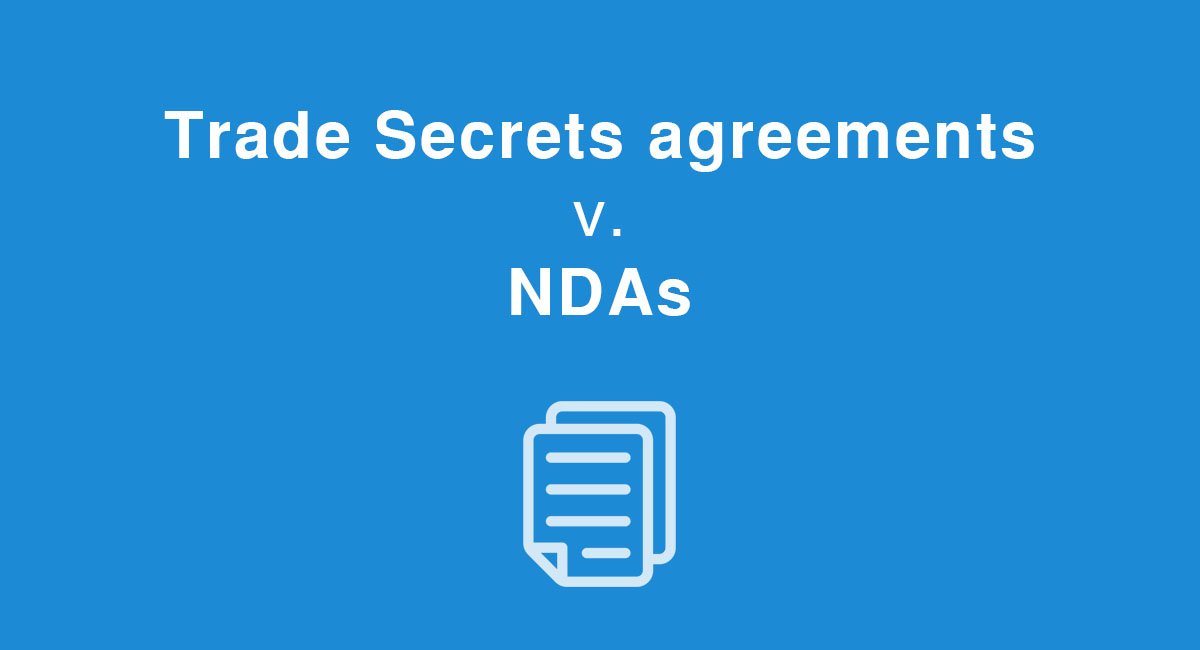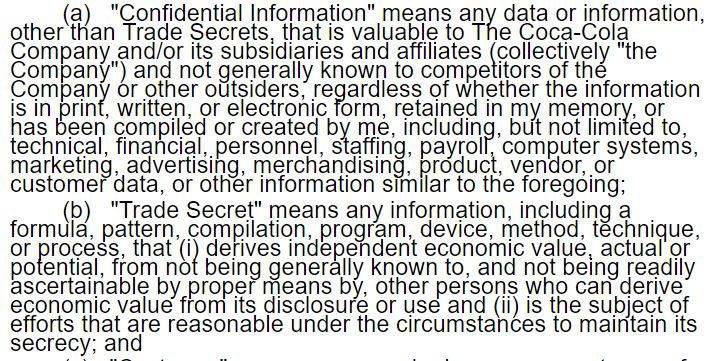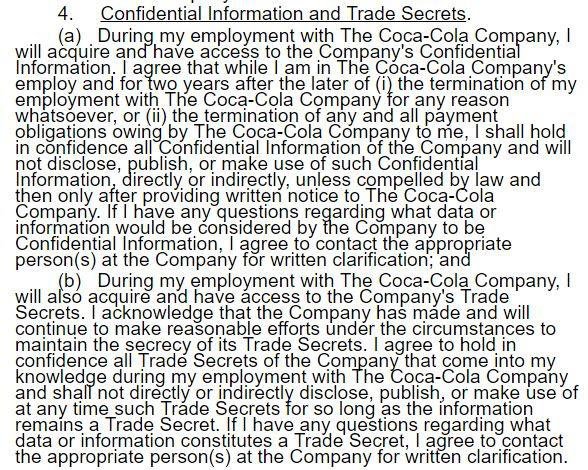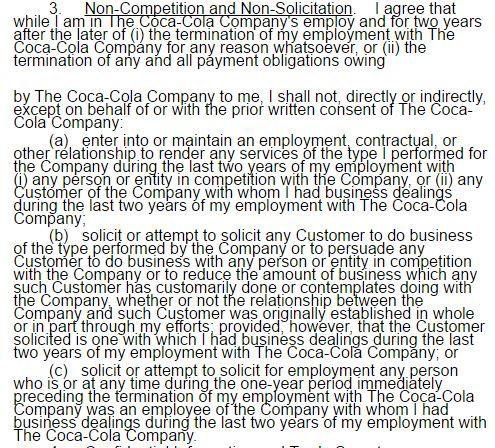Trade Secrets Agreements v. NDAs

Secrets are an important factor for business success. Look at businesses like Coca-Cola and KFC that are built on the foundation of a formula and recipe that have stayed secret for 100 years.
Contents
Have you ever wondered how hugely successful businesses like these have managed to keep their recipes secret for so long?
When a business has something proprietary that gives it commercial advantage such as a formula, recipe, process, technology, design, algorithm or something else that is inherently commercially valuable, businesses place great importance on trying to protect it, not just from competitors but also the public.
Possession of something like a secret recipe or amazing algorithm not only provides a business with commercial advantage but it also enhances its aura of mystique and invites potential customer curiosity. Who wouldn’t be interested in trying a secret recipe for fried chicken?
In order to protect these secrets, there are several common ways that businesses use to protect these secrets. These include using a patent, a non-competing agreement, a non-solicitation agreement and a non-disclosure agreement (NDA).
Each of these legal tools can produce very different results.
The patent
With a patent, you’re establishing a monopoly on a proprietary item but only for a limited amount of time.
In the US, patents run for up to 20 years and 14 years for design patents if the fees are paid regularly. Canadian and UK patents last for 20 years.
Not everything can be patented.
In the US, you cannot patent things like a mathematical formula, naturally occurring substances and laws of nature.
In Canada, a patent can only be applied for something tangible such as an idea and like the US, you cannot patent a scientific principle or an abstract theory.
In the UK, categories like scientific or mathematical discoveries, literary and artistic works, ways of conducting a business and presentation of information, plant and animal varieties and methods for medical treatment or diagnosis won’t qualify for patent protection.
But the more important factor to consider is whether applying for a patent will actually help you to achieve your goals or not.
When filling for a patent, you’re required to reveal all details about your secret and this is made available to the public.
This means that if you desire exclusive proprietary ownership over your innovation, it cannot remain a secret. This may be fine while your patent is in force but patents are not perpetual in nature.
What happens after the patent expires? Technically, anybody can copy and use your patent after it expires.
Also, even while the patent is still in force, there is the risk that your competitor may not copy your patent outright but could come up with a slightly different way of doing what you do and claim it as an independent innovation.
The trade secret
Contrast this with a trade secret.
A trade secret has no time limitation and can last forever. It remains a trade secret indefinitely as long as you can prove that the secret continues to possess commercial value, confers some sort of economic benefit to you and you have made an effort to keep it a secret.
Businesses like Coca-Cola and KFC go to great lengths to protect their secrets.
For example, it has been a belief for decades that only two executives of Coca-Cola know the original secret Coca-Cola formula at any one point and that the original recipe is kept in a vault in Atlanta, Georgia.
Whether this is true or not doesn’t matter but one thing is for sure, they take the protection of the formula very seriously.
On top of this, even if you wanted to produce your own cola brand in the US, there is only one company Stepan’s Co in New Jersey that actually has the permit to import and extract cocaine from coca leaves.
You can be sure that Coca-Cola insisted on an NDA with Stepan’s Co because until now, Stepan has refused to work with any other business apart from Coca-Cola.
KFC operates similarly in such a covert manner and only a handful of employees know its secret recipe of “11 herbs and spices” and reportedly, all these employees have signed confidentiality pledges.
According to reports on KFC, two companies are used to manufacture the secret recipe and each company is only given half of the recipe to prevent either company from knowing the full recipe.
So, besides taking measures to protect your trade secret, what else can you do?
The Non-Disclosure Agreement
The non-disclosure agreement – sometimes shortened as “NDA” – is also known as a trade secret agreement or a confidentiality agreement.
An NDA is a legally binding contract between parties that requires them to keep certain information confidential.
This kind of legal agreement can be used to protect ordinary confidential information or a trade secret.
Definition
A trade secret is treated differently from merely confidential information by the courts.
Trade secrets not only are essential to the commercial viability of a business, but they also possess independent economic value, as long as it remains secret.
To avoid any confusion about what’s confidential information and what’s a trade secret, you should provide a definition of what constitutes a trade secret and what’s confidential information.
Here are examples clauses from Coca Cola’s Agreement on Confidentiality, Non-Competition and Non Solicitation that provides two separate definitions for what qualifies as “confidential information” and what’s classified as “trade secrets“:

On top of providing such a definition in your legal agreement, you should develop a practice of clearly marking information that you disclose as either “Confidential” or “Trade Secret” to avoid confusion.
Indefinite period
In an ordinary NDA, it’s advisable that you specify a defined period of time for which the confidentiality is to last for.
This is to avoid any potential risk of a court declaring that an NDA is too restrictive.
However, this should not apply when it comes to trade secrets.
As we already know, trade secrets can last forever if certain qualifications are met, including taking reasonable measures to protect the trade secret.
Time limits should apply to ordinary, confidential information, but not to trade secrets and you should expressly state this in your NDA. If you are using the legal agreement for trade secrets only, then don’t mention a time limit at all.
Here are example clauses from Coca Cola’s Agreement on Confidentiality, Non-Competition and Non Solicitation that demonstrate the difference in the amount of time confidentiality is expected for information that’s considered a trade secret and what’s merely confidential:

Jurisdiction
It’s also important to specify what jurisdiction will apply to the NDA you’ll draft and send to be signed in the event of the need for court intervention.
As you can imagine, different jurisdictions may deliver very different outcome. If no jurisdiction is provided for and there’s a dispute over the terms/obligations of the legal agreements as to which jurisdiction applies, then you’ll be looking at extra legal costs in order to determine this issue.
An example of a clause that provides for jurisdiction can be found in an NDA from Harvard Business School:

Termination of relationship
You should also specify what you wish the other party to do with any confidential information when your contractual relationship ends or they leave your business.
You could require that the other party returns all originals and copies of the information back to you or destroy them within a certain period of time and retain no other records or copies.
An example of such a clause can be found in Thoughtbot’s Mutual Non-Disclosure Agreement:

NDAs with Non-Compete, Non-Solicitation
A non-compete agreement is a contract that prevents the other party from later on competing with you for a specific period of time and in a certain geographic location.
A pure NDA normally only restricts unauthorized disclosures over confidential information but it doesn’t stop the use of the confidential information once it has been disclosed.
A non-compete agreement can cover this gap.
For example, if you were in the accounting software business, you could require that the other party not set up any competing accounting software business for the next 3 years within the US.
Non-competing agreements are very useful as an addition to a non-disclosure.
This is because it can be very difficult and costly to prove that someone has breached confidentiality and revealed information that they shouldn’t have. However, it’s much easier to prove that someone has set up a competing business with you.
One of the downsides of a non-competing agreement though is that it has to be reasonable as courts loathe to uphold something that comes across as an unfair restraint on commercial competition.
A non-solicitation agreement basically prevents the other party from taking away your employees and customers.
This is especially important if the other party is a high-level senior executive who has built a great relationship with other employees in your business and is well-liked amongst customers.
An example of a combined non-disclosure, non-compete and non-solicitation clauses can be found again in the Coca Cola’s Agreement on Confidentiality, Non-Competition and Non Solicitation:

Using the NDA in patents talks
A patent, and related business talks around a patent, can also be combined with an NDA.
As you already know, the benefit of a patent is that it gives you an ownership right for a period of time but in exchange for that, you have to share your secret with the world.
However, a patent could be paired very well with a trade secret in certain circumstances. If you have an invention that can be easily reversed engineered or copied, a patent may buy you some time over your competitors while you work on developing something that is truly worth protecting as a trade secret.
A patent allows you to establish an initial monopoly over your invention while you continue to work on improving the invention.
You only have to reveal secrets at the time of the filing of your patent application but not while the patent is in force. After your patent application has been approved, you can develop further proprietary items based on your invention without a need to reveal those and you can keep those as trade secrets.
However, this strategy doesn’t suit every proprietary item and if you’re better off not letting the world know about what you have created, it’ll be better to skip the patent application altogether.
The biggest slip-up you can make with a trade secret would be to become too relaxed with your protection of the trade secret, even if you have the NDA in place.
It’s important that even if you have a non-disclosure drafted, signed and agreed by all parties involved, you need to take measures to limit the amount of information and number of people who have access to the trade secret and overall confidential information.
Anytime that a trade secret is shared too willingly and openly, courts have been known to declare that the information no longer qualifies as a trade secret and therefore cannot be enforced as such.
Credits: Icon sheets by Icon Fair from the Noun Project.
Nov 22, 2017 | Non-disclosure Agreements
This article is not a substitute for professional legal advice. This article does not create an attorney-client relationship, nor is it a solicitation to offer legal advice.